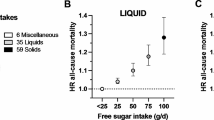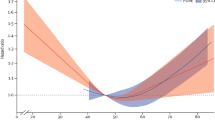Abstract
Fructose and glucose in soft drinks and fruit drinks account for just under 50 % of added sugars. Soft drinks intake has risen five-fold between 1950 and 2000, and this increase in intake of simple sugars has raised health concerns. The risks of cardiovascular disease, obesity and the metabolic syndrome have all been related to consumption of sugar-sweetened beverages in several, but not all meta-analyses. Fructose and sugar-sweetened beverages have also been related to the risk of gout in men, and to non-alcoholic fatty liver disease. Studies show that the calories in sugar-sweetened beverages do not produce an adequate reduction in the intake of other foods, leading to increased caloric intake. Plasma triglycerides are increased by sugar-sweetened beverages, and this increase appears to be due to fructose, rather than to glucose in sugar. Several 10-week to 26-week randomized trials of sugar-containing soft drinks show increases in triglycerides, body weight, and visceral adipose tissue; there were also increases in muscle fat and liver fat, which might lead to non-alcoholic-fatty liver disease.
Similar content being viewed by others
References
Papers of particular interest, published recently, have been highlighted as:• Of importance •• Of major importance
Ogden CL, Yanovski SZ, et al. The epidemiology of obesity. Gastroenterology. 2007;132:2087–102.
Flegal KM, Carroll MD, Ogden CL, Curtin LR. Prevalence and trends in obesity among US adults, 1999-2008. JAMA. 2010;303(3):235–41. Epub 2010 Jan 13.
Swinburn B, Sacks G, Ravussin E. Increased food energy supply is more than sufficient to explain the US epidemic of obesity. Am J Clin Nutr. 2009;90:1453–6.
• Bray G.A. A Guide to Obesity and the Metabolic Syndrome: Origins and Treatment. New York: CRC Press: Taylor and Francis Group. 2011. A thorough and complete review of obesity and the metabolic syndrome with both historical and current areas covered in detail.
Putnam J, Allshouse J, Kantor LS. U.S. per capita food supply trends: more calories, refined carbohydrates and fats. Food Rev. 2002;25(3):2–15.
Duffey KJ, Popkin BM. Shifts in patterns and consumption of beverages between 1965 and 2002. Obesity (Silver Spring). 2007;15(11):2739–47.
Putnam JJ, Allshouse JE. Food Consumption, Prices and Expenditure, 1970–1997. USDA Food & Rural Economic Division, Economic Research Service Bulletin No 965, p. 34.
Ervin RB, Kit BK, Carroll MD, Ogden CL. Consumption of Added Sugar Among U.S. Children and Adolescents, 2005–2008. NCHS Data Brief, Number 87, February 2012.
Malik VS, Popkin BM, Bray GA, Després J-P, Hu FB. Sugar sweetened beverages, obesity, type 2 diabetes and cardiovascular disease risk. Circulation. 2010;121:1356–64.
•• Malik V., G.A. Bray, B.M. Popkin, J.P. Despres, F.B. Hu. Sugar Sweetened Beverages and Risk of Metabolic Syndrome and Type 2 Diabetes: A Meta-Analysis. Diab Care. 2010;33(11):2477-83. This meta-analysis examines the relationship between consumption of calorically sweetened soft drinks and the risk for developing obesity, type 2 diabetes and cardiovascular disease.
Palmer JR, Boggs DA, Krishnan S, Hu FB, Singer M, Rosenberg L. Sugar-sweetened beverages and incidence of type 2 diabetes mellitus in African American women. Arch Intern Med. 2008;168:1487–92.
Paynter NP, Yeh HC, et al. Coffee and sweetened beverage consumption and the risk of type 2 diabetes mellitus: the atherosclerosis risk in communities study. Am J Epidemiol. 2006;164(11):1075–84.
Montonen J, Jarvinen R, et al. Consumption of sweetened beverages and intakes of fructose and glucose predict type 2 diabetes occurrence. J Nutr. 2007;137(6):1447–54.
Bazzano LA, Li TY, et al. Intake of fruit, vegetables, and fruit juices and risk of diabetes in women. Diabetes Care. 2008;31(7):1311–7.
Nettleton JA, Lutsey PL, et al. Diet soda intake and risk of incident metabolic syndrome and type 2 diabetes in the Multi-Ethnic Study of Atherosclerosis (MESA). Diabetes Care. 2009;32(4):688–94.
Dhingra R, Sullivan L, Jacques PF, et al. Soft drink consumption and risk of developing cardiometabolic risk factors and the metabolic syndrome in middle-aged adults in the community. Circulation. 2007;116:480–8.
Lutsey PL, Steffen LM, et al. Dietary intake and the development of the metabolic syndrome: the Atherosclerosis Risk in Communities study. Circulation. 2008;117(6):754–61.
Fung TT, Malik V, et al. Sweetened beverage consumption and risk of coronary heart disease in women. Am J Clin Nutr. 2009;89(4):1037–42.
Choi HK, Curhan G. Soft drinks, fructose consumption, and the risk of gout in men: prospective cohort study. BMJ. 2008;336:309–12.
Aeberli I, Zimmermann MB, Molinari L, et al. Fructose intake is a predictor of LDL particle size in overweight schoolchildren. Am J Clin Nutr. 2007;86:1174–8.
Ludwig DS, Peterson KE, Gortmaker SL. Relation between consumption of sugar-sweetened drinks and childhood obesity: a prospective, observational analysis. Lancet. 2001;357:505–8.
McCaffery JM, Haley AP, Sweet LH, et al. Differential functional magnetic resonance imaging response to food pictures in successful weight-loss maintainers relative to normal-weight and obese controls. Am J Clin Nutr. 2009;90:928–34.
Malik VS, Willett WC, Hu FB. Sugar-sweetened beverages and BMI in children and adolescents: reanalyses of a meta-analysis. Am J Clin Nutr. 2009;89:438–9. author reply 439-40.
Vartanian LR, Schwartz MB, Brownell KD. Effects of soft drink consumption on nutrition and health: a systematic review and meta-analysis. Am J Pub Health. 2007;97:667–75.
Olsen NJ, Heitmann BL. Intake of calorically sweetened beverages and obesity. Obes Rev. 2009;10(1):68–75.
•• Sievenpiper JL, de Souza RJ, Mirrahimi A, et al. Effect of fructose on body weight in controlled feeding trials: a systematic review and meta-analysis. Ann Intern Med. 2012;156:291-304. Review This meta-analysis examines studies in which fructose itself replaced other carbohydrates in either isocaloric or hypercaloric diets. It showed that isocaloric replacement did not affect weight, but that hyperaloric replacement did – both of which would be expected from the concept of energy balance (see #4). However, this meta-analysis excluded the fructose which is contained in high fructose corn syrup or in sucrose, which represents the major source of fructose as “added sugars”. The free fructose as an “added sugar” is only a small part of the diet, thus this meta-analysis is tangential to the current review. Two other papers in this bibliography (# 40 and # 42) use the same data base but examine other responses to “free fructose” added to the diet in place of other carbohydrates.
Sun SZ, Empie MW. Lack of findings for the association between obesity risk and usual sugar-sweetened beverage consumption in adults–a primary analysis of databases of CSFII-1989–1991, CSFII-1994–1998, NHANES III, and combined NHANES 1999–2002. Food Chem Toxicol. 2007;45:1523–36.
• Bray GA, Smith SR, de Jonge L, et al. Effect of dietary protein content on weight gain, energy expenditure, and body composition during overeating: a randomized controlled trial. JAMA. 2012;307(1):47-55. This paper compares the effect of 5%, 15% and 25% protein diets when healthy individuals are overfed by 40% for 8weeks. Calorie intake predicted fat storage, but protein intake did not.
Cohen JC, Schall R. Reassessing the effects of simple carbohydrates on the serum triglyceride responses to fat meals. Am J Clin Nutr. 1988;48:1031–4.
Raben A, Vasilaras TH, Møller AC, Astrup AA. Sucrose compared with artificial sweeteners: different effects on ad libitum food intake and body weight after 10 wk of supplementation in overweight subjects. Am J Clin Nutr. 2002;76:721–9.
Sørensen LB, Raben A, Stender S, Astrup A. Effect of sucrose on inflammatory markers in overweight humans. Am J Clin Nutr. 2005;82:421–7.
Stanhope KL, Schwarz JM, Keim NL, et al. Consuming fructose-sweetened, not glucose-sweetened, beverages increases visceral adiposity and lipids and decreases insulin sensitivity in overweight/obese humans. J Clin Invest. 2009;119:1322–34.
•• Maersk M, Belza A, Stødkilde-Jørgensen H, et al. Sucrose-sweetened beverages increase fat storage in the liver, muscle, and visceral fat depot: a 6-mo randomized intervention study. Am J Clin Nutr. 2012;95:283-9. This randomized parallel arm controlled trial compared ingesting 1 liter of one of four beverages over a 6month period. The beverages included a sugar-sweetened cola, milk, diet cola and water. Both the sugar containing cola and milk have “sugar” but only the sucrose in the cold has fructose – the milk sugar is composed of glucose and galactose. During the 6months when the equivalent of two 16oz beverages were ingested each day, the cola group showed increased visceral fat, liver fat, muscle fat, cholesterol and systolic blood pressure, in comparison with milk or all other groups combined. This suggests that within 6months, two 16oz sugar-containing beverages can mimic the metabolic syndrome.
Nakagawa T, Tuttle KR, Short RA, Johnson RJ. Hypothesis: fructose-induced hyperuricemia as a causal mechanism for the epidemic of the metabolic syndrome. Nat Clin Pract Nephrol. 2005;1(2):80–6.
Choi JW, Ford ES, Gao X, Choi HK. Sugar-sweetened soft drinks, diet soft drinks, and serum uric acid level: the Third National Health and Nutrition Examination Survey. Arthritis Rheum. 2008;59(1):109–16.
Rolls BJ, Kim S, Fedoroff IC. Effects of drinks sweetened with sucrose or aspartame on hunger, thirst and food intake in men. Physiol Behav. 1990;48:19–26.
Mattes RD, Campbell WW. Effects of food form and timing of ingestion on appetite and energy intake in lean young adults and in young adults with obesity. J Am Diet Assoc. 2009;109:430–7.
Mourao DM, Bressan J, Campbell WW, Mattes RD. Effects of food form on appetite and energy intake in lean and obese young adults. Int J Obes (Lond). 2007;31:1688–95.
Havel PJ. Dietary fructose: implications for dysregulation of energy homeostasis and lipid/carbohydrate metabolism. Nutr Rev. 2005;63:133–57. Review.
Johnson RJ, Perez-Pozo SE, Sautin YY, et al. Hypothesis: could excessive fructose intake and uric acid cause type 2 diabetes? Endocr Rev. 2009;30(1):96–116. Review.
Teff KL, Grudziak J, Townsend RR, et al. Endocrine and metabolic effects of consuming fructose- and glucose-sweetened beverages with meals in obese men and women: influence of insulin resistance on plasma triglyceride responses. J Clin Endocrinol Metab. 2009;94(5):1562–9.
Brown CM, Dulloo AG, Yepuri G, Montani JP. Fructose ingestion acutely elevates blood pressure in healthy young humans. Am J Physiol. 2008;294:R730–7.
Tappy L, Randin JP, Felber JP, et al. Comparison of thermogenic effect of fructose and glucose in normal humans. Am J Physiol. 1986;250:E718–24.
Ha V, Sievenpiper JL, de Souza RJ, et al. Effect of fructose on blood pressure: a systematic review and meta-analysis of controlled feeding trials. Hypertension. 2012;59:787–95.
Nakagawa T, Hu H, Zharikov S, et al. A causal role for uric acid in fructose-induced metabolic syndrome. Am J Physiol Renal Physiol. 2006;290:F625–31.
Perez-Pozo SE, Schold J, Nakagawa T, Sánchez-Lozada LG, Johnson RJ. Lillo JL Excessive fructose intake induces the features of metabolic syndrome in healthy adult men: role of uric acid in the hypertensive response. Int J Obes (Lond). 2010;34:454–61.
Wang DD, Sievenpiper JL, de Souza RJ, Chiavaroli L, Ha V, Cozma AI, et al. The effects of fructose intake on serum uric acid vary among controlled dietary trials. J Nutr. 2012;142(5):916–23.
Buemann B, Toubro S, Holst JJ, Rehfeld JF, Bibby BM, Astrup A. D-tagatose, a stereoisomer of D-fructose, increases blood uric acid concentration. Metabolism. 2000;49(8):969–76.
Nseir W, Nassar F, Assy N. Soft drinks consumption and nonalcoholic fatty liver disease. World J Gastroenterol. 2010;16:2579–88.
Disclosure
G. Bray: Consultancy for Takeda Global Development, provided expert testimony to Abbott Laboratories and received payment for lectures from Medifast and Global Direction in Medicine.
Author information
Authors and Affiliations
Corresponding author
Rights and permissions
About this article
Cite this article
Bray, G.A. Fructose and Risk of Cardiometabolic Disease. Curr Atheroscler Rep 14, 570–578 (2012). https://doi.org/10.1007/s11883-012-0276-6
Published:
Issue Date:
DOI: https://doi.org/10.1007/s11883-012-0276-6




